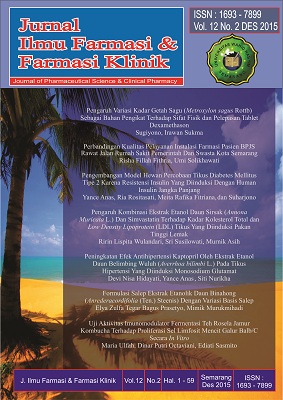Main Article Content
Abstract
ABSTRACT
Hyperinsulinemia may precede insulin resistance in patients with Type 2 diabetes. In this
study, we tried to reveal an influence of long-term treatment of human insulin to hyperglycemic
and insulin resistance in male Wistar rats. Before the experiment, blood-glucose levels measured
two hours after 2 g/Kg glucose imposition. Rats receive human insulin (0.45-1.80) IU/KgBW/day
subcutaneously every day for 14 days.  Furthermore, human insulin 1.8 IU/KgBW/day also
provide a period of7,14and 21days. At theend of the experiment,we mademeasurements ofblood-
glucoselevelstwo hoursafterthe imposition glucose.There are, the influence oflong-termtreatment
of human insulin determined bycomparing the blood-glucoselevelsbeforeandafter insulin
treatment. Insulin resistance isdeterminedby comparing thehypoglycemiceffect of glibenclamide
10 mg/Kg BW to the control group. The results concluded that the humaninsulin1.80
IU/KgBW/day treatment for 14dayscan improveblood-glucoselevel'sWistarmale ratsup
to126.369mg/dL(p<0.05)withpatternsdoes notdepend onthe length of timeof administration.The
averageof % hypoglycemiceffect of glibenclamide10mg/kgBWÂ in ratswhoreceived treatment with
human insulin 1.80IU/kg BW/dayswereat 18,31%,smaller thancontrols (62.20%) (p<0.05).
Decrease in hypoglycemic effects of glibenclamide 10 mg/kg BW caused by mice has insulin
resistance might be due to a result of long-term insulin administration.
Keywords : Human insulin, insulin resistance, Type 2 diabetes animal models
Hyperinsulinemia may precede insulin resistance in patients with Type 2 diabetes. In this
study, we tried to reveal an influence of long-term treatment of human insulin to hyperglycemic
and insulin resistance in male Wistar rats. Before the experiment, blood-glucose levels measured
two hours after 2 g/Kg glucose imposition. Rats receive human insulin (0.45-1.80) IU/KgBW/day
subcutaneously every day for 14 days.  Furthermore, human insulin 1.8 IU/KgBW/day also
provide a period of7,14and 21days. At theend of the experiment,we mademeasurements ofblood-
glucoselevelstwo hoursafterthe imposition glucose.There are, the influence oflong-termtreatment
of human insulin determined bycomparing the blood-glucoselevelsbeforeandafter insulin
treatment. Insulin resistance isdeterminedby comparing thehypoglycemiceffect of glibenclamide
10 mg/Kg BW to the control group. The results concluded that the humaninsulin1.80
IU/KgBW/day treatment for 14dayscan improveblood-glucoselevel'sWistarmale ratsup
to126.369mg/dL(p<0.05)withpatternsdoes notdepend onthe length of timeof administration.The
averageof % hypoglycemiceffect of glibenclamide10mg/kgBWÂ in ratswhoreceived treatment with
human insulin 1.80IU/kg BW/dayswereat 18,31%,smaller thancontrols (62.20%) (p<0.05).
Decrease in hypoglycemic effects of glibenclamide 10 mg/kg BW caused by mice has insulin
resistance might be due to a result of long-term insulin administration.
Keywords : Human insulin, insulin resistance, Type 2 diabetes animal models
